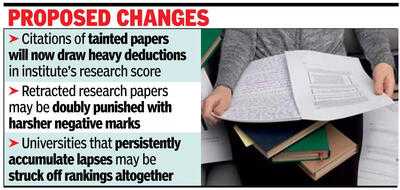MUMBAI: Centre is rewriting the rulebook for India’s National Institutional Ranking Framework ( NIRF ), in what could be the sharpest overhaul of the country’s higher education rankings since their inception in 2015. For the first time, penalties are being formally stitched into the ranking methodology, signalling a tougher stance on research malpractice and misrepresentation of data. The negative marking system will soon be declared.
This year, the framework docked some marks from an institute’s overall score if published papers were retracted by academic journals. From the coming year, though, the consequences will be deeper and wider. Not only will universities be penalised for retracted work, but even citations of such tainted papers will draw heavy deductions in the research score — effectively broadening the circle of accountability.

The change is aimed at curbing what officials describe as a “weakness” in India’s research ecosystem. Papers withdrawn for plagiarism, duplication or manipulated data often continue to be cited, giving them a false academic afterlife. “Retractions damage the credibility of the system.
And when retracted papers are cited, they really hold no meaning. And hence, such instances need to be doubly punished with harsher negative marks,” said professor Anil Sahasrabudhe , chairman of the ranking committee. By extending penalties to citations, he explained, govt is signalling zero tolerance towards dishonesty in academic output.
The revised rules will also push institutions to institute stronger internal checks. Universities that persistently accumulate lapses may face the ultimate penalty — being struck off the rankings altogether. “While the final decision to debar institutes that continue to deliberately misrepresent has not yet been taken, the committee is serious about such cases and is likely to consider harsh measures,” added Sahasrabudhe .
“Rankings are signals to students, employers, investors of faith in an institution. To be rubbed off the table would mean more than a bruise to reputation; it may mean a shut door to opportunity,” said an official.
NIRF evaluates institutions across five broad parameters: teaching and learning, graduation outcomes, research, outreach and perception. With over 8,700 institutions participating in the 2024 cycle, its results have become a widely referenced barometer for students, recruiters and policymakers.
Experts point out the higher education sector is at a crossroads: on the one hand, the country seeks a larger global footprint in research and innovation, and on the other, it must work to weed out malpractice that risks damaging credibility. Sharper rules, they argue, are a warning and an opportunity. Universities need to invest in ethics training , plagiarism detection systems & transparent review mechanisms, lest a single tainted citation pull down their standing, said Sahasrabudhe.
This year, the framework docked some marks from an institute’s overall score if published papers were retracted by academic journals. From the coming year, though, the consequences will be deeper and wider. Not only will universities be penalised for retracted work, but even citations of such tainted papers will draw heavy deductions in the research score — effectively broadening the circle of accountability.
The change is aimed at curbing what officials describe as a “weakness” in India’s research ecosystem. Papers withdrawn for plagiarism, duplication or manipulated data often continue to be cited, giving them a false academic afterlife. “Retractions damage the credibility of the system.
And when retracted papers are cited, they really hold no meaning. And hence, such instances need to be doubly punished with harsher negative marks,” said professor Anil Sahasrabudhe , chairman of the ranking committee. By extending penalties to citations, he explained, govt is signalling zero tolerance towards dishonesty in academic output.
The revised rules will also push institutions to institute stronger internal checks. Universities that persistently accumulate lapses may face the ultimate penalty — being struck off the rankings altogether. “While the final decision to debar institutes that continue to deliberately misrepresent has not yet been taken, the committee is serious about such cases and is likely to consider harsh measures,” added Sahasrabudhe .
“Rankings are signals to students, employers, investors of faith in an institution. To be rubbed off the table would mean more than a bruise to reputation; it may mean a shut door to opportunity,” said an official.
NIRF evaluates institutions across five broad parameters: teaching and learning, graduation outcomes, research, outreach and perception. With over 8,700 institutions participating in the 2024 cycle, its results have become a widely referenced barometer for students, recruiters and policymakers.
Experts point out the higher education sector is at a crossroads: on the one hand, the country seeks a larger global footprint in research and innovation, and on the other, it must work to weed out malpractice that risks damaging credibility. Sharper rules, they argue, are a warning and an opportunity. Universities need to invest in ethics training , plagiarism detection systems & transparent review mechanisms, lest a single tainted citation pull down their standing, said Sahasrabudhe.
You may also like

Prince William reveals how he and Kate told their children about her cancer battle

Greece braced for another massive 48hr storm after flooding chaos

Netflix's 'disturbing' crime drama based on real-life tragedy is 'addictive' to watch

Prince William shows his true colours in bombshell TV episode with Eugene Levy

Royal fans in awe of Princess Kate's one move at RAF Coningsby






